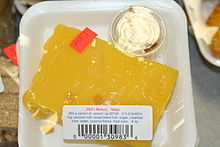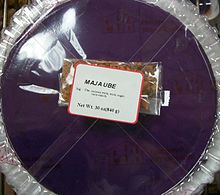- Maja blanca
-
Maja blanca 
Maja blanca con maizOrigin Alternative name(s) Coconut pudding, Coconut cake Place of origin Philippines Dish details Course served Dessert Serving temperature room temperature, cold Main ingredient(s) Coconut milk, cornstarch Variations Maja blanca con maiz. Maja de ube Maja blanca (Tagalog pronunciation: [ˈmaha ˈblaŋkə] mah-a-blank-ə) is a Filipino dessert made primarily from coconut milk. It is also known as coconut pudding or coconut cake.
Contents
Description
Maja blanca has the consistency of thick gelatine and a delicate flavor. As the name suggests, the dish is creamy white in color. It is usually served during fiestas and holiday gatherings.
Preparation
Maja blanca is relatively easy to prepare. A coconut milk (not coconut cream) and cornstarch mixture is heated to boiling over a low flame while stirring. Corn kernels, milk, and sugar are also often added, though these are not traditionally part of the recipe.[1] Once the mixture thickens, it is then poured into serving dishes previously greased with coconut oil and allowed to cool. Once firm, latik (browned coconut cream curds) are then sprinkled as toppings.[2]
It is also often refrigerated and served cold to improve the texture.[3]
Etymology and nomenclature
The name maja blanca is from Spanish for "white belle" (see also majo).[4]
Maja blanca are also known as maja blanca con maiz, maja maiz, or maja blanca maiz when corn kernels are used in the preparation (maiz is Spanish for corn).[2]
Variations
Maja blanca can easily be adapted to include various other ingredients. Examples include squash maja blanca which uses calabazas (Filipino: kalabasa)[5] and a version of maja maiz that uses butter, resulting in a distinctive yellow color.[6]
Another variation of maja blanca is the maja de ube (or maja ube). It uses ube (purple yam) as one of the primary ingredients giving it a characteristic deep purple color.[7]
See also
- Philippine cuisine
- List of dishes using coconut milk
- Espasol
- Leche flan
- Sapin-sapin
References
- ^ Vanjo Merano (November 8, 2009). "Maja Blanca". Panlasang Pinoy. http://panlasangpinoy.com/2009/11/08/filipino-asian-dessert-sweet-corn-kakanin-maja-blanca-recipe/. Retrieved July 4, 2011.
- ^ a b Reynaldo G. Alejandro & Doreen G. Fernandez (1998). Food of the Philippines. Tuttle Publishing. p. 102. ISBN 9789625932453. http://books.google.com/books?id=m6ZKZ1wHioMC&lpg=PP1&pg=PA102#v=onepage&q&f=false.
- ^ J. Dagoon (2005). Home Economics Technology IV. Rex Bookstore, Inc.. p. 89. ISBN 9789712342219. http://books.google.com/books?id=gBSvzimIaAYC&lpg=PP1&pg=PA89#v=onepage&q&f=false.
- ^ E. Cross Saltire (June 3, 2008). "Sweet Cat's Tongue for Merienda". The Theoretical Chef. http://bangusbelly.blogspot.com/2008/06/sweet-cats-tongue-for-merienda.html. Retrieved July 4, 2011.
- ^ Regional Field Unit No. 5. Emily B. Bordado. ed. Vegetable-based recipes. Department of Agriculture, Republic of the Philippines. p. 11. http://bicol.da.gov.ph/News/2009/Vegetable-based%20recipes.pdf.
- ^ "Maja Maiz". Home Cooking Rocks!. July 30, 2004. http://homecookingrocks.com/maja-maiz/. Retrieved July 4, 2011.
- ^ Dagoon, et al. (1999). Culinary Arts I. Rex Bookstore, Inc.. p. 269. ISBN 9789712326035. http://books.google.com/books?id=zlEc2n2rFrgC&lpg=PP1&pg=PA269#v=onepage&q&f=false.
Philippine cuisine Individual dishes Desserts - See also: List of Philippine dishes
- Philippine condiments
- Kapampangan cuisine
- List of Philippine restaurant chains
Categories:
Wikimedia Foundation. 2010.

